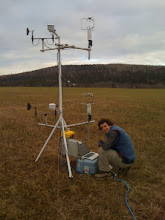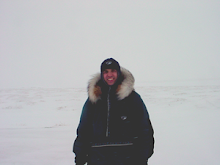Thursday, November 19, 2009
Profiler in action!
The inlet of the CRDS automatically moves up and down throughout the night to sample air at two different levels. So far, we have seen lower concentrations of N2O5 at the lower level. This suggests N2O5 is being deposited to the snowpack. This data, coupled with vertical wind speeds, can be used to calculate a flux, or deposition rate, to the snowpack.
Subscribe to:
Post Comments (Atom)



2 comments:
Nice work, wondering if thermal stratification is has a high enough gradient at those height differences to affect partitioning/concentration of the N2O5 as well? Not really sure if stratification would be seen over such small distances, ie air density would change at all. Also could it be possible to see partitioning by thermal differences in the snow pack, like in a core sample, perhaps playing out at thaw time? Prolly too small to measure. Just silly questions really.
Hi Chris- In order to calculate the flux of N2O5 and deposition to the surface we did have to filter out a % of data when the atmosphere was too stable. The height difference is a two fold problem. We want to have a large enough difference within our met tower capabilities and not too high to limit out our fetch (undistributed flat area in the main sampling direction). This is the very short answer, it is chapter 3 in my thesis!
Post a Comment